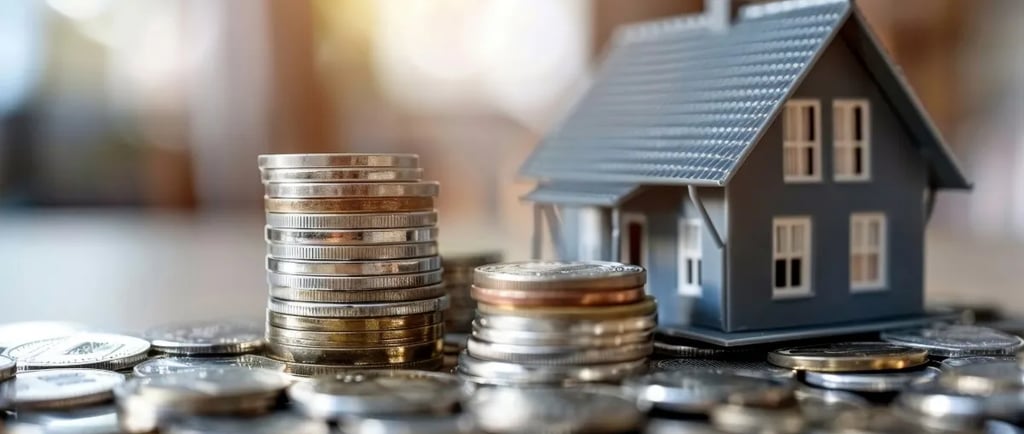How do down payments impact mortgage rates?
Unlock a lower mortgage rate! Discover how a bigger down payment reduces your loan amount and interest, saving you money on your home.
2/4/20255 min read


The journey to homeownership is often an exciting and complex one, filled with important financial decisions. Among these, the size of a down payment stands out as a critical factor. While it may seem like a simple upfront cost, a down payment has a profound and positive influence on the financial terms of a mortgage, most notably the interest rate.
This guide provides a comprehensive overview of the powerful connection between down payments and mortgage rates. It explores why lenders view a larger down payment as a sign of financial strength and how this can lead to a more favorable mortgage, saving a homeowner a significant amount of money over the life of a loan.
Understanding the Lender's Perspective: A Focus on Risk
To fully appreciate the impact of a down payment, it is helpful to understand the process from a lender’s point of view. A mortgage is a substantial, long-term loan, and a financial institution's primary goal is to minimize risk. Risk, in this context, is the possibility that a borrower may be unable to repay the loan.
A down payment is a fundamental measure of a borrower's financial stability and serious intent. A larger down payment demonstrates a lower-risk profile, and lenders reward this with better loan terms. The core reasons for this relationship are as follows:
A Lower Loan Amount: A down payment directly reduces the amount of money that needs to be borrowed. For a $400,000 home, a 20% down payment ($80,000) means the loan amount is only $320,000. This smaller loan presents less financial exposure for the lender, making it a safer and more attractive investment for the institution.
A Higher Personal Stake: A substantial down payment shows that the borrower has a significant financial stake in the property. This personal investment serves as a strong incentive to maintain consistent mortgage payments, thereby protecting that investment. Lenders interpret this as a powerful sign of a reliable and motivated borrower.
A Lower Loan-to-Value (LTV) Ratio: When a larger down payment is made, the LTV ratio is lower because it's a direct comparison of the loan amount to the home's value. For instance, an 80% LTV ratio indicates that the borrower has paid 20% of the home's value upfront. A lower LTV ratio signals lower risk to the lender, as there is a larger cushion to protect their investment in the event of a market downturn or foreclosure. Lenders are more inclined to offer a more competitive interest rate to borrowers who meet this standard.
The Strategic Advantage of a 20% Down Payment
The 20% down payment is often referred to as the gold standard in conventional mortgage lending for a good reason. Meeting this threshold unlocks a suite of financial advantages, with a more favorable interest rate being a major benefit. This is a key reason why down payments impact mortgage rates.
Access to Better Interest Rates: A key benefit of a down payment of 20% or more is the potential for substantial long-term savings. This is achieved by securing a more competitive interest rate.When a down payment creates a lower LTV ratio, lenders see it as a minimal-risk loan and often offer the best rates available. Even a small drop in the interest rate can accumulate to tens of thousands of dollars in savings over the life of a 30-year mortgage, significantly reducing the total cost of homeownership.
Elimination of Private Mortgage Insurance (PMI): One of the most significant benefits of a 20% down payment is the avoidance of Private Mortgage Insurance.Private Mortgage Insurance (PMI) is an extra monthly charge for conventional loans with a down payment under 20%. This insurance protects the lender, not the homeowner, against a potential default. By making a 20% down payment, this extra monthly cost is eliminated, leading to a lower and more manageable monthly mortgage payment.
Building Equity from Day One: A larger down payment means a homeowner begins with a more significant portion of the home's value already paid off. This initial home equity provides a stronger financial foundation and can offer greater flexibility in the future for purposes such as home renovations or other financial needs.
The Down Payment in a Broader Context
While a down payment is a powerful factor, it is part of a larger financial profile that lenders evaluate. A holistic assessment of a borrower's financial health is conducted to determine the final mortgage rate. Key factors that work in concert with a down payment include:
Credit Score: A high credit score is a crucial indicator of a history of responsible debt management. This, combined with a strong down payment, positions a borrower to receive the most favorable interest rates.
Debt-to-Income (DTI) ratio:The DTI is a simple calculation that measures a borrower’s total monthly debt against their gross monthly income.. A lower Debt-to-Income ratio demonstrates a healthy financial position & the capacity to comfortably manage new mortgage payments.
Loan Term: The length of the mortgage, such as a 15-year or 30-year term, also influences the mortgage rate. Shorter-term loans generally come with lower interest rates because the lender's risk is contained over a shorter period.
Understanding how down payments impact mortgage rates is essential for any potential homebuyer. The size of the down payment is a fundamental element in the lending process.
The Impact on Total Cost of Ownership
The true value of a substantial down payment is realized over the entire life of the loan. It has a direct effect on the total cost of homeownership over time. A lower interest rate means less money is paid toward interest over the life of the loan. This can result in tens of thousands of dollars in savings, money that can be used for other financial goals, investments, or home improvements. Furthermore, the absence of mortgage insurance payments for those with a 20% down payment contributes to these savings, making the overall cost of the home more affordable. A larger down payment ultimately leads to a smaller mortgage loan amount, which means less is borrowed and less interest accrues.
The strategic decision to make a larger down payment, therefore, is not just about a lower initial rate but about a more cost-effective financial plan for the entire duration of the loan.
A Strategic Decision for Long-Term Financial Health
Choosing the amount for a down payment is a highly personal decision. While it may be appealing to make the smallest down payment possible to conserve cash, a larger upfront investment can lead to significant and lasting benefits. It is an opportunity to not just purchase a home, but to build a strong financial future from the start. This is why the question of how down payments impact mortgage rates is so important.
By understanding how a down payment positively impacts a mortgage rate, borrowers can make a strategic and confident decision. A larger down payment can be a powerful tool for securing a more favorable mortgage, a lower monthly payment, and a faster path to building home equity. This understanding empowers a borrower to secure better financial terms and sets the stage for long-term financial success as a homeowner.
Don't navigate the mortgage process alone. Find the right solution for you by visiting Danny Bertolini at https://www.dannybertolini.com/
Hello, I’m Danny Bertolini, Vice President at Meadowbrook Financial Mortgage Bankers Corp.
Useful Links
Subscribe to our newsletter
© 2025 Danny Bertolini. All Rights Reserved. | Meadowbrook Financial Mortgage Bankers Corp. | NMLS #167666
